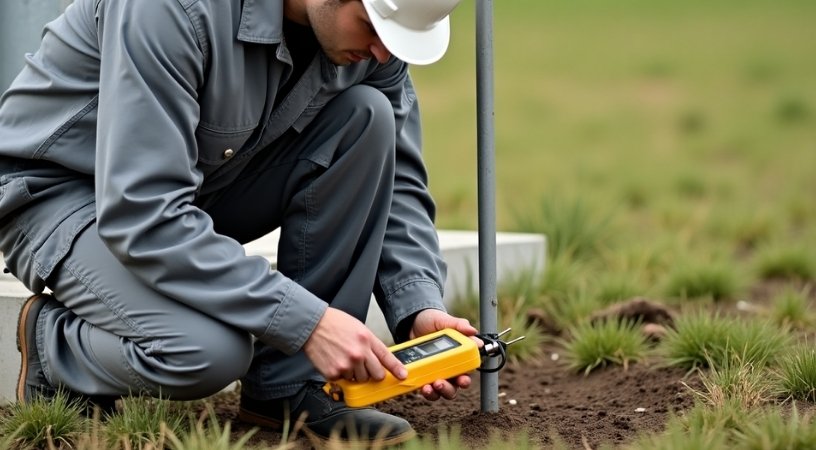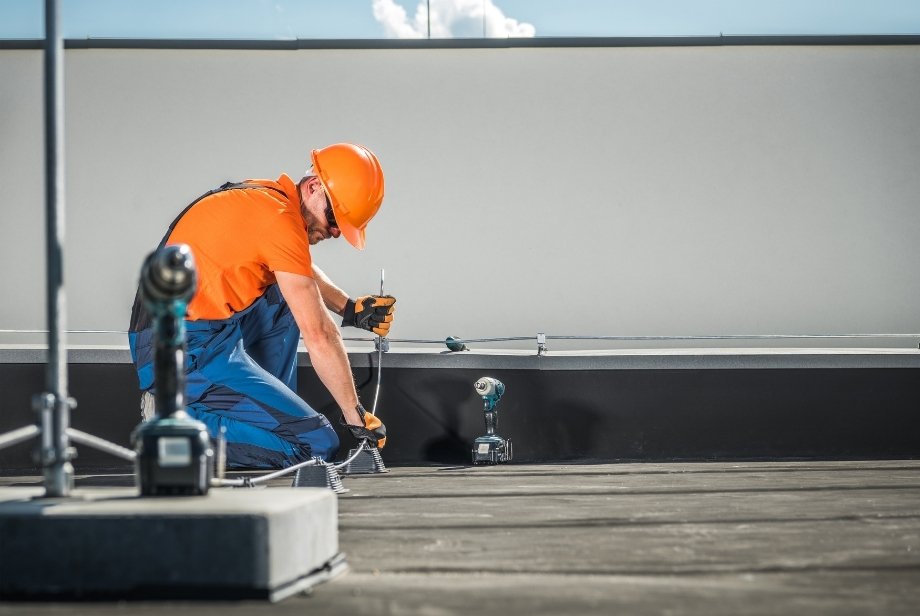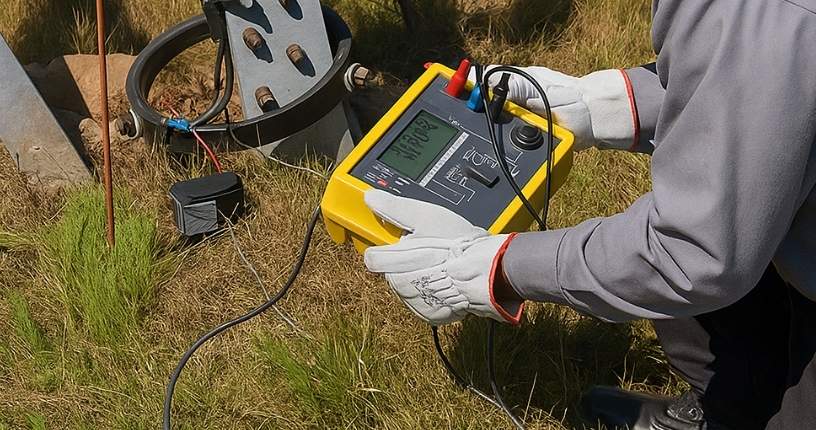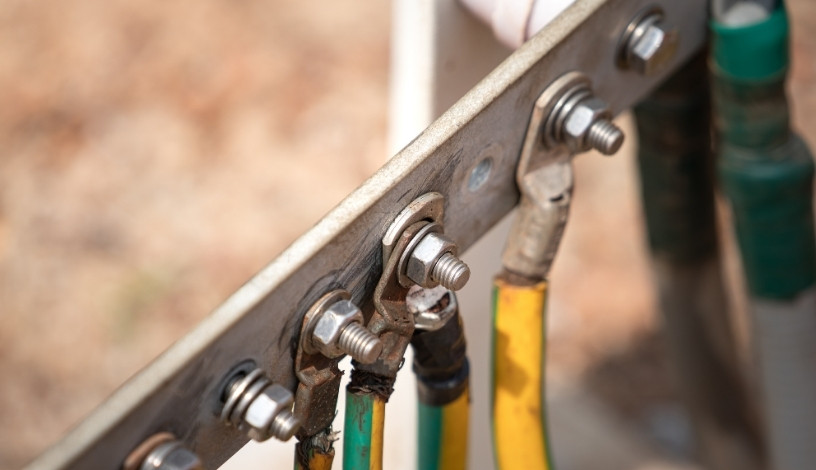
We provide comprehensive earthing testing services in Hatch Lane that ensure your lightning protection system works when it matters most. Our certified engineers test ground resistance, soil resistivity, and earthing systems to BS EN 62305 standards, delivering digital reports that prove compliance and protect your property, people, and insurance cover.
A lightning protection system is only as effective as its earth termination. Poor earthing can cause the entire system to fail during a lightning strike, diverting dangerous energy into your building's infrastructure or putting lives at risk. Even a perfectly designed lightning protection system becomes useless if the earth path is loose, corroded, or degraded.
We specialise in professional earthing testing that verifies your grounding system can safely dissipate lightning energy into the ground. Our testing ensures your system meets the strict resistance levels required by BS EN 62305 and provides the peace of mind that comes with knowing your protection works.

Ground resistance testing forms the backbone of any effective lightning protection system. We conduct earth ground testing using calibrated digital meters to measure the resistance between grounding electrodes and earth. For lightning protection systems, earth resistance typically needs to be below 10 ohms, though we often target even lower values for sensitive environments.
Our ground resistance testing includes:
The selective testing method uses advanced equipment to isolate and test individual earth electrode of interest without disconnecting the grounding system. This approach is particularly valuable for businesses that cannot afford downtime during testing.
Soil resistivity earth ground conditions directly impact your earthing system's performance. We perform comprehensive soil resistivity testing to understand how effectively your ground setup can dissipate electrical energy. The test done to measure soil composition, moisture content, and seasonal variations helps us recommend the most effective grounding electrode arrangements.
Our soil resistivity testing automatically calculates soil resistance using ohms law principles. We test current flow through the soil in a direct measurement process, providing data that helps determine the optimal depth of the ground electrodes and spacing requirements.
Different methods of testing earth resistance include four-point testing methods that generate a known current through temporary ground stakes. This approach ensures proper distance apart ensures accurate readings while accounting for the diameter and length factors that affect ground resistance.
We evaluate complete earthing systems to ensure they meet modern safety standards. Our assessment covers the resistance between a grounding electrode and earth, checking that all connections remain secure and that the overall grounding system continues to provide effective protection.
Key aspects of our earthing systems testing include:
Our Hatch Lane engineers use tools built to make earth ground tests more efficient and accurate. These specialized instruments can measure the ground resistance while accounting for variables like electrodes under test conditions and ambient electrical interference.
We employ multiple testing approaches to ensure comprehensive coverage:
Stakeless Earth Ground Testing: Perfect for situations where installing temporary ground stakes would be impractical. This method uses electromagnetic principles to measure earth resistance without requiring direct soil penetration.
Selective Earth Ground Testing: Essential for complex installations with parallel grounds or multiple earthing points. The selective testing method uses frequency-selective techniques to isolate individual earth paths.
Clamp Meter Testing: When the clamp meter is connected around earth conductors, it can quickly verify the effectiveness of the grounding system without disconnection or system shutdown.
We conduct earth ground testing using methods that automatically calculate soil resistance and provide immediate readings. Our approach ensures that installations isolating the system during testing don't compromise ongoing operations.


The Electricity at Work Regulations 1989 require that electrical systems, including earth paths, be maintained in a condition that prevents danger. For lightning protection systems, this means regular verification that your earthing arrangement can handle the massive currents involved in lightning strikes.
Many businesses in Hatch Lane ask, is lightning protection a legal requirement? While not always explicitly mandated, BS EN 62305 emphasises that earthing must safely dissipate lightning currents without creating dangerous step or touch voltages. Our testing proves compliance with these critical safety standards.
Many businesses in Hatch Lane fail to test their earthing systems regularly, meaning potential system failure during storms may go unnoticed until it's too late. Insurance companies increasingly require proof of regular testing and maintenance for lightning protection systems.
Our digital reports provide the documentation needed for insurance claims and demonstrate your commitment to safety management.
Inadequate earthing creates serious risks:
Regular testing identifies these issues before they become dangerous or costly problems.
For lightning protection systems, we typically target earth resistance below 10 ohms, though lower values provide better protection. In high-risk installations like petrochemical plants, we often aim for resistance values of 1 ohm or less.
The specific target depends on:
Soil resistivity varies dramatically based on local conditions:
Our testing accounts for these variables and provides recommendations for maintaining consistent performance year-round.


We begin every project with a thorough site assessment, reviewing existing earthing arrangements and identifying any obvious issues. This includes examining the kind of ground setup you're looking for and determining the most appropriate testing methods.
Our testing protocol includes:
We perform ground testing using calibrated equipment that meets current British Standards. Our approach ensures accuracy while minimising disruption to your operations.
Every test generates a comprehensive digital report that includes:

At Lightning Protection Testing UK, we provide more than just compliance — we deliver peace of mind.
All our engineers are trained and certified to current British lightning protection standards.
We serve commercial, industrial, and residential properties across the entire UK.
Fast inspections and repairs after storm activity or suspected lightning strikes.
Detailed test certificates and inspection records suitable for insurers and regulatory authorities.
From hospitals and schools to heritage-listed buildings — we’ve done it all.
All new lightning protection systems require commissioning tests to verify correct installation and performance. We test soil resistivity, connect test equipment, and verify that resistance measurements meet design specifications.
BS EN 62305 recommends regular testing of earthing systems, typically annually or after significant weather events. This ensures ongoing protection and identifies deterioration before it compromises safety. For those unfamiliar, understanding what is BS EN 62305 is essential—it outlines procedures to assess lightning protection and earthing effectiveness.
Any changes to your lightning protection or electrical systems may affect earthing performance. We verify that modifications haven't compromised the grounding system effectiveness.
Many insurers require regular earthing system testing as part of their risk management requirements. Our certified reports provide the documentation needed to maintain coverage.


For buildings requiring lower ground resistance, we design and test multi-rod arrangements. Two earth stakes installed at proper distances can significantly reduce overall system resistance compared to single electrode installations.
In high-resistance soil areas, we may install earth rods up to 10-30 metres deep to achieve target resistance values. Our testing verifies these deep systems perform as designed.
Where vertical electrode installation isn't practical, we test horizontal conductor arrays that can provide effective earthing over larger areas. The length and arrangement of these systems directly affects their ability to reduce ground resistance.
Our engineers hold relevant qualifications and regularly update their knowledge of current standards. As a trusted lightning protection company in Hatch Lane, we understand both the technical requirements and practical challenges of earthing system testing.
We provide end-to-end earthing services from initial design through installation, testing, and ongoing maintenance. This integrated approach ensures consistency and accountability across all project phases.
We invest in the latest testing equipment, including stakeless testers, selective measurement systems, and earth ground clamp meters. Our tools automatically calculate resistance values and provide reliable, repeatable results.
Our reports clearly explain test results, compliance status, and any recommended actions. We provide the evidence you need for insurance, regulatory compliance, and peace of mind.



Earthing testing is the process of measuring the effectiveness of a building’s grounding system to ensure it safely diverts electrical faults. It helps protect people and property from electric shocks and fire risks.
Earthing systems in the UK should typically be tested every 1 to 3 years, depending on usage and regulation. High-risk or industrial environments may require more frequent testing.
An earthing test involves measuring the resistance of the earthing system using specialised equipment. The goal is to confirm the system meets safety standards and effectively channels fault currents.
Earthing testing costs in the UK typically range from £150 to £400 depending on property size and complexity. Larger commercial sites may incur higher charges.
Earthing testing is legally required under UK electrical safety regulations for landlords. It must be part of the Electrical Installation Condition Report (EICR) every five years.
The risks of not testing your earthing system include electric shock hazards, equipment damage, and fire risks. Poor earthing can also invalidate insurance policies.